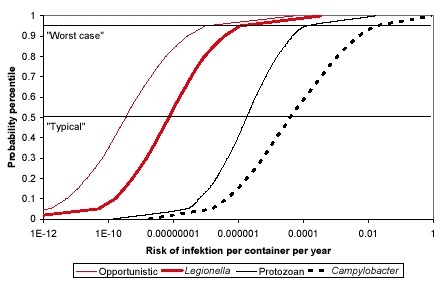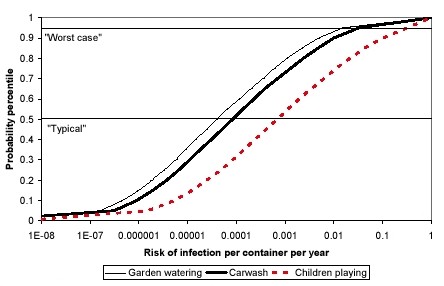| Forside | | Indhold | | Forrige | | Næste |
Risk Assessment of the Use of Stormwater in Private Gardens
Summary and conclusions
Stormwater collected from roofs is often used for watering of gardens and for similar purposes in Danish households. This might cause infections as the microbiological quality if the water is poor, below the requirements set for bathing waters. However, the risk of being infected by Legionella and opportunistic pathogens is very small. Campylobacter and protozoa involves a higher risk. If children, while playing, accidentally drink the water there may be a risk of infection.
Background and objectives
The interest in reducing water consumption is increasing, e.g. by reuse of different kinds of wastewater. Stormwater collected from roofs is relatively unpolluted and can under certain conditions be reused. However, stormwater runoff has a completely different composition than stormwater itself, therefore it is necessary in every single case to evaluate whether the different forms of reuse pose health risks.
The project is based on selected pathogenic micro organisms and indicator bacteria and on other micro organisms which are likely to pose a health risk.
The objective of the project is to evaluate the health risk connected with reuse of run-off from the roof for different purposes. In this case, health risks cover risks related to human handling of roof run-off for different purposes. The project includes reuse for outdoor purposes in single-family house gardens.
The Study
The study was accomplished as a risk assessment. The risk assessment focussed on typical reuse of roof run-off: watering gardens, car wash and children playing outdoor. The use and the resulting effect on human beings are described mathematically. Thus, a possible risk can be calculated as the rate of infections, e.g. one out of n children are infected when playing with roof run-off in the garden. At the same time this enables comparison with other forms of reuse and with other risks. To the extent possible the assessments are based on typical Danish conditions.
The major part of the study consists of a) collection and verification of micro organisms which can be found in stormwater run-off from roofs; and b) concentrations, frequency and volumes of ingestion of roof run-off by human beings and the related risks.
The risk assessment calculates the risks when using the storm water. The total number of pathogens in the garden is not significantly increased by use of the storm water. The risk of infection when staying in the garden and eating vegetables grown in the garden is therefore not greater in gardens where storm water is used than in other gardens.
Main Conclusions
For pathogens for which quantitative calculations are possible the risk per year is stated for different kinds of reuse. The study aims at keeping the necessary assumptions neutral and conservative. The actual risks are expected to be lower than calculated.
Calculations have been made for four types of pathogens:
- Opportunistic pathogens, corresponding to Aeromonas spp and
Pseudomonas spp
- Legionella spp.
- Protozoan, corresponding to Giardia spp. and Cryptosporidium spp.
- Campylobacter spp.
Salmonella is not included in the study, as literary studies demonstrated a low risk, since Salmonella rarely occurs in roof run-off.
For the two pathogens Mycobacterium Avium-complex and Listeria, it has not been possible to make a quantitative calculation of the risk. However, these pathogens are estimated not to involve a higher health risk than the other pathogens.
The risk of infection is very low for Legionella as well as the opportunistic pathogens. The highest risks were calculated at exposure of Campylobacter and protozoan. In some instances, the calculated risks are close to the US EPA limit values for risk of infection of potable water corresponding to one out of 10,000 exposed human beings each year. Under special circumstances, the risk can be considerably higher; up to one out of three instances per year, can be demonstrated if children ingest considerable volumes of water with high Campylobacter concentration.
The risk can be reduced by using only water which has been stored for a minimum of 10 days; by separating the first part of the run-off; and by handling the water so that it does not come into contact with children.
As a whole it is assessed that reuse of stormwater in Denmark may under adverse circumstances, e.g. ingestion of exceptionally large volumes by children and other particularly sensitive humans, present a ris of infection due to exposure of pathogenic bacteria and parasites.
Under ordinary conditions the risk of infection in connection with reuse of roof run-off in gardens is considered small.
Project Results
Risk assessment is accomplished in four steps:
- Hazardous identification
- Assessment of exposure
- Analysis of dose response
- Calculation and assessment of risks
Each step is described below.
Hazardous identification.
If run-off is stored and handled locally, there may be an extraordinary risk of exposure in relation to infectious matters and other potential parameters in the roof run-off. Many of the undesirable substances are found in gardens already, but are often inaccessible, e.g. in the form of bird droppings. Local handling often results in diluted and thus invisible pathogens and also a higher risk of exposure of human beings than before. The calculated risk is the probability that a specific use entails infection.
Only few studies have been reported on the occurrence of pathogens and indicator organisms in roof run-off. The most comprehensive study, which includes several hundred samples, was made in Germany and New Zealand, while only very few samples were taken in Denmark. The few samples taken in Denmark generally show a high concentration of pathogens compared to foreign studies.
The content of indicator organisms varies considerably in the available studies. Therefore a total distribution of concentrations was applied for the selected indicators, E. coli, enterococci and faecal coli bacteria. The microbial quality of the water does not meet the requirements for bathing water. The average pathogen content will be 0.1-1% of the content of indicator organisms. This result does, however, not apply to the individual tank. Absence of indicator organisms cannot be used to disclaim a risk of infection in a specific tank.
Assessment of exposure
Based on an estimation of the demand for use of the collected stormwater and on the frequency of filling the tank, it is assumed that an ordinary tank will be used 10 times a year with confidence limits of 2-18 times.
It is assumed that every time the tank is emptied one person will be exposed. As for watering and car washing, the exposed person will typically be the person doing the job, whereas exposure of airborne pathogens (Legionella) affects the person standing in the direction of the wind.
Analysis of dose response.
Human beings react differently to certain doses of pathogens. Some human beings are easily infected, e.g. if they are immunocompromised, whereas others are hard to infect, e.g. if they have previously been exposed to the illness. Consideration of each pathogen was based on the few studies accomplished with healthy, adult test persons. The test results were extrapolated to the best possible estimate of the relation between dose and response in the Danish population.
Calculation and assessment of risks.
All processes described involve a considerable uncertainty. Thus, the results will also involve a certain uncertainty. Figure 0.3 shows the calculated annual risk for watering of gardens. Low numbers means low risk. Campylobacter make up the highest risk with a calculated risk in the worst-case situation of approximately 2% each year. The worst case situation is a mixture of adverse circumstances as regards pathogens in the tank, large ingestion and sensitive persons. The typical risk is defined as typical content volume in the tank, typical ingestion and a person ingesting a typical amount of pathogens in order to be infected.

Figure 0.3.
Calculated distribution of annual risk of infection for four types of pathogens when using run-off for watering. The Legionella curve indicates an upper limit, whereas the actual risk is believed to be 100-1000 times lower. Note that the X-axis is log-transformed.
In figure 0.4 the different scenarios are compared using Campylobacter as example. The largest risk occurs when children playing in the garden accidentally ingest the water as the ingestion in this situation is considerably higher than for the other scenarios.

Figure 0.4.
Comparison of risk of infection per year per tank for Cryptosporidium at different applications of the run-off. The figure shows that the risk is considerably higher for children playing in the garden than for other applications, as the ingestion of water is considerably higher. Note that the X-axis is log-transformed.
| Forside | | Indhold | | Forrige | | Næste | | Top |
|